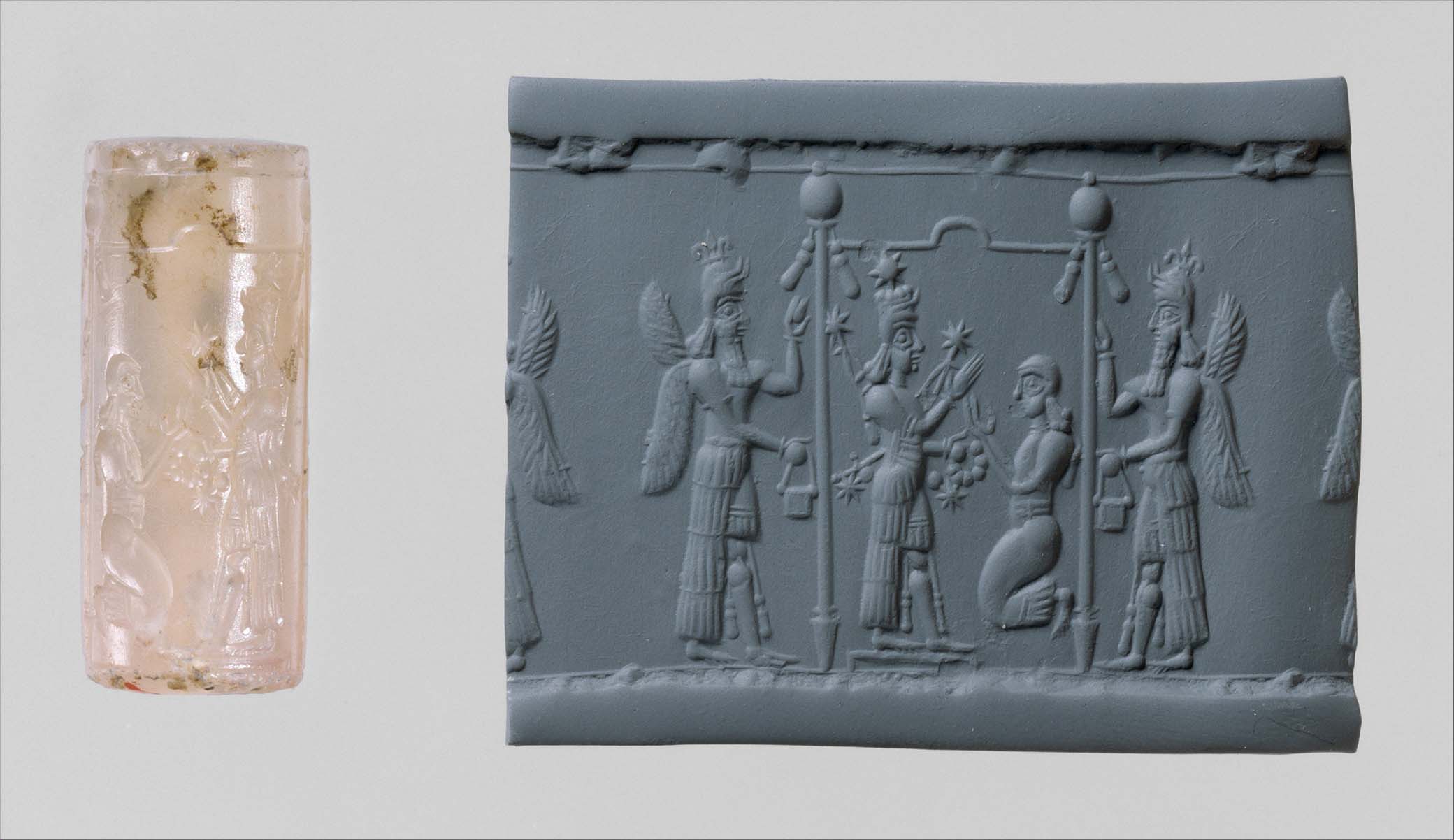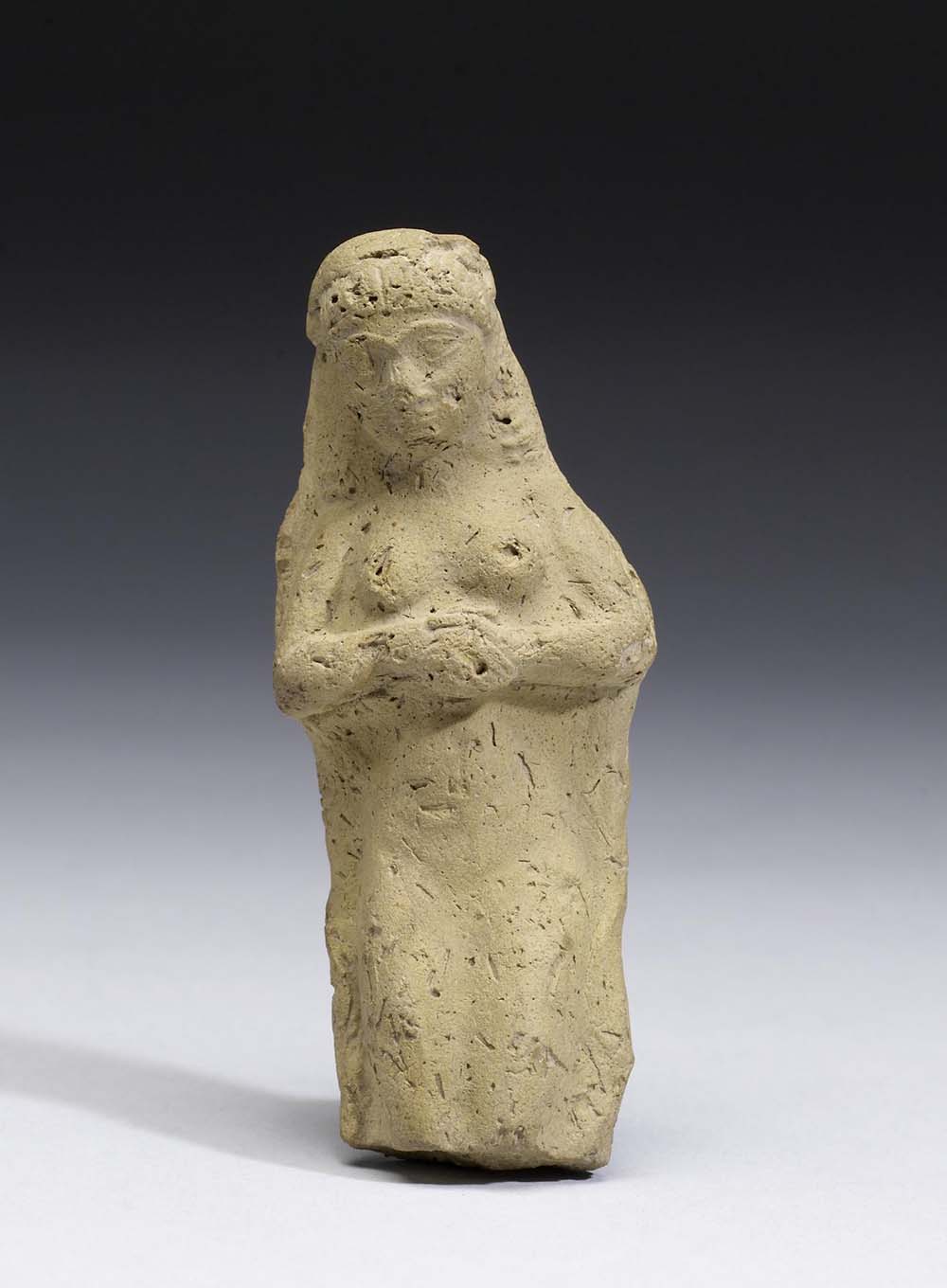
Cylinder seal, circa eighth century bc. The Metropolitan Museum of Art, gift of Martin and Sarah Cherkasky, 1989.
Assyrian families of the imperial period tended to be small. A husband would normally live with his wife and children, sometimes a few slaves, and occasionally also his parents, in his private residence. Women from well-off families would bring a dowry into the marriage, consisting of jewelry, textiles, containers, toiletry articles, tools, furniture, and silver. In the case of divorce, it would remain in the woman’s possession, providing her with some material security.
The primary purpose of marriage in Assyria was to produce offspring. Children, apart from bringing joy, were expected to take care of their parents when the latter grew old, to bury them—normally in vaults located below the family home—and to keep their memory alive by performing monthly rituals in honor of the dead. But as in all premodern societies, in Assyria, too, being pregnant and giving birth were fraught with danger. Due to poor hygiene and an inability to cope competently with obstructed labor, postpartum hemorrhage, and childbed fever, maternal mortality was high.
Not only the mothers but also their babies were at grave risk when something went wrong, whether at birth or in the weeks and months thereafter. How miserable the loss of children could make their parents is indicated by a letter from Adad-shumu-usur, a leading exorcist, to King Esarhaddon: “As to what the king, my lord, wrote to me: ‘I am feeling very sad; how did we act that I became so depressed for this little one of mine?—well, had it been curable, you would have given away half of your kingdom to have it cured. But what can we do? O king, my lord, it is a matter where nothing can be done.”
In the absence of effective medical treatments, young couples would resort to apotropaic rituals and incantations to ward off the dangers associated with giving birth and raising young children. Because the fundamentally benevolent gods could not be deemed responsible for the loss of pregnant women and little babies, people projected their fears onto a malevolent, baby-snatching demoness named Lamashtu, a kind of anti-mother who was depicted with a lion’s head, the talons of a bird, and the upper body of a female. At her sagging breasts, a piglet and a dog could nurse, and her clawed fingers sometimes grasped snakes. In the incantations that were used to battle her, Lamashtu is said to “count the months” of the mothers about to give birth, and “mark their days on the wall,” before “slithering into a locked house” to “strangle the young children.”
One way to get rid of this terrifying demoness—and secure a safe delivery and life for the children—was to produce a figurine of her, recite incantations over it, and then dispose of it in the steppe or set it on a little boat that was placed on the Tigris and sent away downstream. Another way to counter Lamashtu was to solicit the help of a second supernatural being, Pazuzu, “the king of the evil wind demons.” Sporting taloned feet and hands, a leonine face with protruding eyes, and an erect penis (all of which gives him an appearance similar to that of the Egyptian god Bes), Pazuzu looked almost as scary as Lamashtu, but served as an agent of “white magic”: his powers were used to drive the evil child-eater away. Small Pazuzu heads could be worn on clothes or around the neck, while larger amulets depicting the demon were set up in domestic spaces to protect pregnant women and small children. Pazuzu had a spectacular comeback in the 1971 novel The Exorcist and the subsequent film adaptation—but these immensely popular specimens of the horror genre associate him with the devil, rather than casting him in the benevolent role he actually played in Assyria and Babylonia.
While normally greeted with great happiness, the arrival of a healthy new child also brought challenges, as parents up to the present day know only too well. At night babies were often crying, which would wake up the parents and, much worse, disturb the house ghosts, among them the easily irascible kusarriku, a kind of semidivine bull-man. To hush their little ones and keep the domestic spirits at ease, parents would sing lullabies, some of which are known from cuneiform handbooks. The Assyro-Babylonian cradlesongs ask why the baby had not cried while still in the womb and entreat it in poetic language to be as calm as well water, “to be given sleep like a sleepy gazelle buck,” and to doze like a shepherd nodding mid-watch.
Every so often, wives would suspect their husbands of erotic indiscretions. A liver omen known from several clay tablets from Nineveh reads, “If the Presence (a feature of the liver) is like the sting of a scorpion, the wife of a man, with her crotch burning, will set the man’s house on fire.” A commentary note added to this entry explains, “If you have the word ‘crotch’ before you: ‘crotch’ refers to jealousy: she is jealous and therefore sets the man’s house on fire.” Wives, too, of course, could fancy a partner outside of marriage—and were thought to sometimes become so fed up with their husbands that they were capable of taking rather drastic steps to escape their marital bonds. As another liver omen states, “If lines are drawn three times between the Presence and the Path (two features of the liver), the wife of a man will keep on sending messages (to another man) with instructions to kill her husband, saying: ‘Kill my husband and marry me!’”

Most Neo-Assyrian texts dealing with women were composed and written by men and reflect specifically male perspectives. A satirical literary dialogue between a weak-minded master and his savvy slave is a case in point. In the text, the master, unsure what could give his life meaning, proposes a series of activities, only to immediately change his mind and give up his plan. Each time, the slave provides a good reason for action or inaction. One stanza outlines the benefits and—in the most literal sense—the pitfalls of becoming attached to a woman:
Slave, listen to me!—Here I am, my lord, here I am.
I am going to love a woman—So love, my lord, love!
The man who makes love to a woman forgets sorrow and fear.
No, slave, I shall not make love to a woman.
Then do not make love, my lord, do not make love.
A woman is a pitfall, a real pitfall, a hole, a ditch!
A woman is a sharp iron dagger that cuts a young man’s throat.
In the patriarchal world of eighth- and seventh-century Assyria, women were normally expected to behave as in the Roman adage “She served her household, she made wool.” But there were exceptions. Neo-Assyrian women whose husbands had died or had become incapacitated would often take over the family business. Temple priestesses, too, were more independent than was typical of women.
There were also a certain number of women who lived completely outside the domestic sphere, whether as prophetesses, tavern keepers, or prostitutes. But they were often social outcasts and occasionally suspected to be witches. The image of womanhood as a threat to order and cosmic harmony is also found in religious contexts, whether in the figure of Lamashtu or that of Tiamat, the primeval originator of the gods in the Babylonian Epic of Creation, who later sought to annihilate her own offspring.
Many powerful goddesses of earlier times, for example Nisaba, a deity associated with writing and bringing in the harvest, had been demoted by the first millennium bc and no longer played a prominent role. On the other hand, the people of Neo-Assyrian times worshipped with all the fervor they could muster the goddess Ishtar, patroness of love and war, defender of gender fluidity, and the only deity who had ever descended to the netherworld and ascended to heaven. It seems as if all the repressed urges to escape from the patriarchal restrictions of everyday life were projected onto this one goddess, the embodiment of contrariness and transgression.
Excerpted from Assyria: The Rise and Fall of the World’s First Empire by Eckart Frahm. Copyright © 2023 by Ekhart Frahm. Available from Basic Books, an imprint of Hachette Book Group, Inc.
